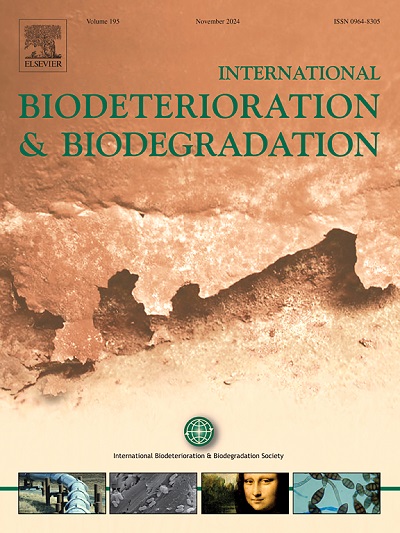Biogenic palladium nanoparticles reclaimed by a novel strain Citrobacter braakii Z1 accelerating RDX biodegradation in the munition effluent
IF 4.1
2区 环境科学与生态学
Q2 BIOTECHNOLOGY & APPLIED MICROBIOLOGY
International Biodeterioration & Biodegradation
Pub Date : 2025-03-22
DOI:10.1016/j.ibiod.2025.106075
引用次数: 0
Abstract
The microbial degradation of high-energy explosives has emerged as a cost-effective environmental remediation strategy, but is hindered by low degradation efficiency due to the slow electron transfer. Biogenic Pd0 nanoparticles (bio-Pd0) demonstrate dual functionality, maintaining catalytic activity for N-NO2 bond reduction while substantially enhancing electron transfer efficiency. This study introduces an innovative single-cell system that synergistically combines chemical catalysis with biological enhancement through in situ synthesis of nanoparticles. Comprehensive characterization through electron microscopy, spectroscopic analysis, and electrochemical measurements revealed that bio-Pd0 synthesized by Citrobacter braakii Z1 (C. braakii Z1) were preferentially localized in the periplasmic space and extracellular matrix, forming a stable hybrid named bio-Pd0@C. braakii Z1. This process relied on the bio-reduction mediated by biohydrogen and extracellular electron transfer processes via c-type cytochromes (c-Cyts) and flavins. Notably, RDX (hexahydro-1,3,5-trinitro-1,3,5-triazine) degradation efficiency increased from 11 % with microbes alone to nearly 100 % with bio-Pd0. Although the observed RDX degradation in inactivated bio-Pd0@C. braakii Z1 and the detected hydrogenolysis intermediates indicated the participation of chemical catalysis, the negative correlation between RDX degradation rate with the Pd:biomass ratios suggested the biology process dominated RDX degradation. Meanwhile, the higher output current in bio-Pd0@C. braakii Z1 and the extracellular electron consumption by RDX indicated the bio-Pd0-mediated extracellular biodegradation was the primary driver for improved RDX removal efficiency. Toxicity evaluation confirmed that the in-situ combination of Pd-catalyzed chemical destruction and biological enhancement in a single cell is a feasible and environmentally friendly strategy for RDX removal with a reduced ecological risk.

一种新型布拉基柠檬酸杆菌Z1回收的生物源钯纳米颗粒加速了弹药废水中RDX的生物降解
微生物降解高能炸药已成为一种具有成本效益的环境修复策略,但由于其电子转移缓慢,降解效率较低。生物源Pd0纳米粒子(bio-Pd0)具有双重功能,既能保持N-NO2键还原的催化活性,又能显著提高电子传递效率。本研究介绍了一种创新的单细胞系统,通过原位合成纳米颗粒,将化学催化与生物增强协同结合。通过电子显微镜、光谱分析和电化学测量等综合表征表明,由braakii Citrobacter braakii Z1 (C. braakii Z1)合成的bio-Pd0优先定位于质周空间和细胞外基质,形成稳定的杂交产物bio-Pd0@C。braakii Z1。该过程依赖于生物氢介导的生物还原和通过c型细胞色素(c-Cyts)和黄素介导的细胞外电子转移过程。值得注意的是,RDX(六氢-1,3,5-三硝基-1,3,5-三嗪)的降解效率从单独使用微生物的11%提高到使用bio-Pd0的近100%。虽然观察到RDX降解在灭活bio-Pd0@C。brakii Z1和检测到的氢解中间体表明参与了化学催化,RDX降解率与Pd:生物量比呈负相关,表明生物过程主导了RDX降解。同时,bio-Pd0@C输出电流较高。brakii Z1和RDX的胞外电子消耗表明,生物pd0介导的胞外生物降解是提高RDX去除效率的主要驱动因素。毒性评价证实,在单细胞中原位结合pd催化的化学破坏和生物增强是一种可行的、环保的、降低生态风险的RDX去除策略。
本文章由计算机程序翻译,如有差异,请以英文原文为准。
求助全文
约1分钟内获得全文
求助全文
来源期刊
CiteScore
9.60
自引率
10.40%
发文量
107
审稿时长
21 days
期刊介绍:
International Biodeterioration and Biodegradation publishes original research papers and reviews on the biological causes of deterioration or degradation.

 求助内容:
求助内容: 应助结果提醒方式:
应助结果提醒方式:


